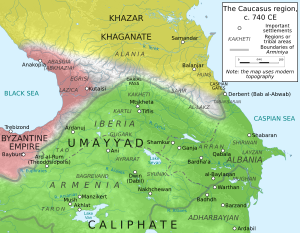
Back Şirvan ərəbləri Azerbaijani Արաբները Կովկասում Armenian Арабы на Кавказе Russian Kafkasya Arapları Turkish Kavkazdagi arablar Uzbek 阿拉伯裔高加索人 Chinese

Arabs first established themselves in the Caucasus in the eighth century, during the Arab conquest of Persia (see also Muslim conquest of Armenia and Arab rule in Georgia). The process of shrinking of the Abbasid Caliphate in the tenth century was followed by the establishment of several Arab-ruled principalities in the region, chiefly the principality of Shirvan (most of present-day Azerbaijan and southeast part of Dagestan) ruled by the Mazyadid dynasty. As the rulers of Shirvan (known as Shirvanshahs) spread their control over much of the Southeast Caucasus and at the same time found themselves more and more isolated from the Arab world, they were undergoing gradual Persianisation. Arab personal names of the Shirvanshahs gave way to Persian ones, members of the ruling dynasty were claiming Ancient Persian descent (possibly having intermarried with members of local pre-Islamic nobility)[1] and Persian gradually became the language of the court and the urban population,[2] while the rural population continued to speak the indigenous languages of Caucasian Albania. However by the seventeenth century[3] a local Turkic idiom (which later would develop into modern Azeri) became the language of everyday life, as well as the language of interethnic communication.[4]
Arab migration continued during the Middle Ages. Nomadic tribes of Arabs occasionally made their way into the region undergoing assimilation by the local population. In 1728, a Russian-Swedish officer named Johann-Gustav Gärber described a group of Sunni Arab nomads who rented winter pastures near the Caspian shores of Mughan (in present-day Azerbaijan).[5][6] It is likely that the Arab nomads arrived in the Caucasus in the sixteenth or seventeenth century.[7] In 1888, an unknown number of Arabs still lived in the Baku Governorate of the Russian Empire.[8][9]
- ^ V. Minorsky, A History of Sharvan and Darband in the 10th-11th Centuries, Cambridge, 1958.
- ^ История Востока. В 6 т. Т. 2. Восток в средние века. М., «Восточная литература», 2002. ISBN 5-02-017711-3 (History of the East. In 6 volumes. Volume 2. Moscow, publishing house of the Russian Academy of sciences «East literature»): The polyethnic population of Albania left-bank at this time is increasingly moving to the Persian language. Mainly this applies to cities of Aran and Shirvan, as begin from the ninth-tenth centuries named two main areas in the territory of Azerbaijan. With regard to the rural population, it would seem, mostly retained for a long time, their old languages, related to modern Daghestanian family, especially Lezgin.
- ^ Adam Olearius. Description of travels of the Holstein Ambassadors to Muscovy and Persia.
- ^ Barthold, W., C.E. Bosworth "Shirwan Shah, Sharwan Shah. "Encyclopaedia of Islam. Edited by: P. Bearman, Th. Bianquis, C.E. Bosworth, E. van Donzel and W.P. Heinrichs. Brill, 2nd edition
- ^ Genko, A. The Arabic Language and Caucasian Studies. USSR Academy of Sciences Publ. Moscow-Leningrad. 8–109
- ^ Richard Tapper. Frontier Nomads of Iran: A Political History of the Shahsevan. Cambridge University Press, 1997; p. 103
- ^ Zelkina, Anna. Arabic as a Minority Language. Walter de Gruyter, 2000; p. 101
- ^ Baynes, Thomas Spencer (ed). "Transcaucasia." Encyclopædia Britannica. 1888. p. 514
- ^ Americanized Encyclopædia Britannica. v.9. Belford-Clarke co., 1890; p.5899